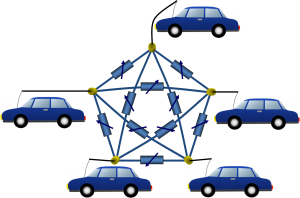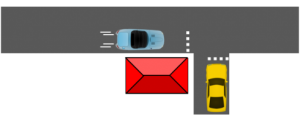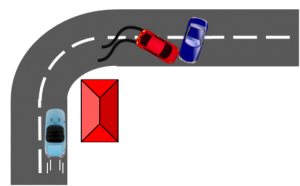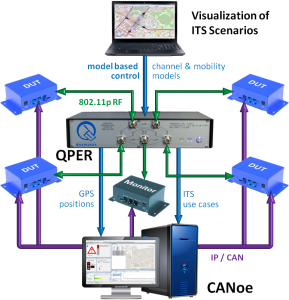網站連結: http://www.qosmotec.com/products/car2x-test-systems/
|
Qosmotec 專注於網絡運營商和基礎設施供應商的測試需求。 Qosmotec 為電信和交通系統開發測試解決方案。
Testing real-life car-to-x communication scenarios is a big challenge for the automotive industry. The execution of drive tests requires high organizational effort and besides that, drive tests are irreproducible due to the high dynamics between the communication partners. Qosmotec contributes emulation systems to equip test benches in the lab:
-
The Car-2-X adaptation of the QPER system emulates signal strength conditions between cars and allows to execute virtual drive tests reproducibly on a test bench. IEEE 802.11p capable radio modules are interconnected with each other via fully controllable radio links.
-
The software CANoe from Vector Informatik is a test tool to access to all possible interfaces in a vehicle. In combination with the Car-2-X adaptation of CANoe, QPER provides for a fully automated test system for simulating, supervising and analyzing the communication between connected cars on a test bench.
Car-to-X Signal Strength Emulator
QPER-C2X is a special adaptation of the signal strength emulator QPER, designed for mobile and Vehicular Ad-hoc Networks (MANet and VANet). Every radio devices in such an infrastructure-less network acts as a sender, receiver, and forwarder (router). Therefore, the ports of the QPER-C2X hardware are fully connected with each other by dynamically controllable attenuators. The system is fully designed for frequencies up to 6 GHz, since wireless communication for Intelligent Transport Systems (ITS) is based on the WLAN standard IEE 802.11p from 5.850 MHz to 5.925 MHz. The connected ITS stations can be either on-board units, as they are built into cars, or road side units that are used by road infrastructure (traffic lights, road work area delimiters, velocity signs). For tests in the lab, radio modules of such ITS stations are each kept in a shielding box that prevents any unwanted radiation over the air.
Virtual drive test software adapted to VANet simulation
The attenuator settings are done by the QPER virtual drive test software – an easy and intuitive approach to create real-life like RF scenario tests. In a graphical user interface, the testers can drag and drop objects, that symbolize the usage of the radio device (cars, traffic lights, signs), onto a map. For creating a traffic scenario, users can specify trips and speeds for the cars. While executing such a traffic scenario, signal strength between all involved radio devices is calculated and the attenuator settings on all links are updated accordingly.
Signal strength calculation based on propagation effects
For calculating signal strengths, QPER takes the following parameters into account that are relevant for the radio channels:
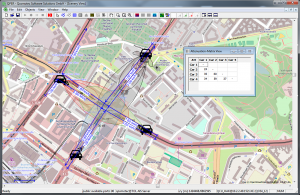
-
Distances between objects in the simulation
-
Antenna radiation patterns that are either given by the radiation diagram of the used antenna or by the installation within the vehicle
-
Shadowing between objects caused by buildings or other vehicles
-
Fast Fading effects caused by multipath signal propagation
Optionally, the QPER hardware can be equipped with additional phase shifters (delay lines) on the radio links. This allows an even more precise emulation of multi-antenna systems, for example, if a car has front- and rear or side-mirror and roof antennas. In these setups, the delay lines emulate the phase differences of the various radio paths carrying identical channel information.
Traffic models cover all Day-One applications
Typical examples for traffic scenarios that can easily be created on a test bench are the Day-One applications for taking the Car-to-X communication on the road:
|
Road Works |
|
|
Emergency Break |
|
|
Traffic Jam |
|
|
Slow Vehicle Ahead |
|
|
Vehicle in Approach |
|
|
Intersection Collision |
|
|
Obstacle behind curve |
Car-to-X Test Bench
The QPER-C2X adaptation, that emulates signal strength between radio devices for Car-to-X communication in the lab, can be combined with the test automation software CANoe from Vector Informatik to enable a fully automated lab test under realistic radio conditions. This combination can be regarded as full test bench setups for Car-to-X test laboratories.
CANoe software awakens traffic situations created with QPER-C2X to life in the test lab. It ensures that the ITS radio devices – each of them protected from external disturbances in a shielding box – communicate with each other as they would do on roads. CANoe provides the same information and data, that would also be available in the car and that are necessary for sending Car-to-X specific messages. These are
-
The current vehicle position
-
The vehicle’s speed
-
The vehicle’s orientation
-
Basic sensor measurements of electronic devices in the car that could be of relevance for other road users (like slippery underground)
Examples for communication between vehicles are
Cooperative Awareness – ITS stations broadcast every second a Cooperative Awareness Message (CAM) with their current position. Thus, all ITS capable stations have a permanent picture of the traffic in its neighborhood.
Decentralized Environmental Notification – ITS stations interact with each other by broadcasting safety relevant information to warn drivers about any kind of hazardous situations on the road. The Decentralized Environmental Notification Messages (DENM) contain information about the exact position and the road hazard, e.g., a closed road lane because of road works or a broken down vehicle behind a curve.
CANoe supervises which messages are sent and received by ITS stations. In combination with the field strength emulator QPER, tests get a comprehensive overview about the complete communication flow in a traffic situation, i.e., which messages are sent and received when, at which position, and under which radio channel conditions. Having this information, engineers can assess, to what extent the cooperative communication among the cars would have really brought a benefit for the driver or if he would have received significant information too late to react on it.
Thus, a laboratory test bench consisting of QPER-C2X and CANoe allows testing interaction among ITS stations from different vendors, but also among various car manufacturers or models under real-life field conditions.
-
Qosmotec Car-to-X Signal Strength Emulator
Qosmotec QPER-C2X is a special adaptation of the signal strength emulator QPER, designed for mobile and Vehicular Ad-hoc Networks (MANet and VANet). Every radio devices in such an infrastructure-less network acts as a sender, receiver, and forwarder (router). Therefore, the ports of the QPER-C2X hardware are fully connected with each other by dynamically controllable attenuators. The system is fully designed for frequencies up to 6 GHz, since wireless communication for Intelligent Transport Systems (ITS) is based on the WLAN standard IEE 802.11p from 5.850 MHz to 5.925 MHz. The connected ITS stations can be either on-board units, as they are built into cars, or road side units that are used by road infrastructure (traffic lights, road work area delimiters, velocity signs). For tests in the lab, radio modules of such ITS stations are each kept in a shielding box that prevents any unwanted radiation over the air. -
Qosmotec Car-to-X Test Bench
The Qosmotec QPER-C2X adaptation, that emulates signal strength between radio devices for Car-to-X communication in the lab, can be combined with the test automation software CANoe from Vector Informatik to enable a fully automated lab test under realistic radio conditions. This combination can be regarded as full test bench setups for Car-to-X test laboratories.



